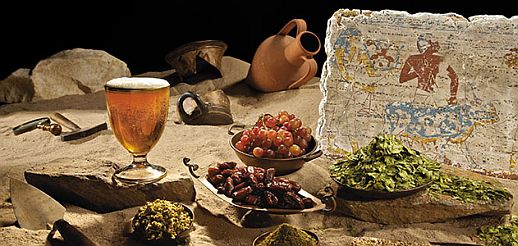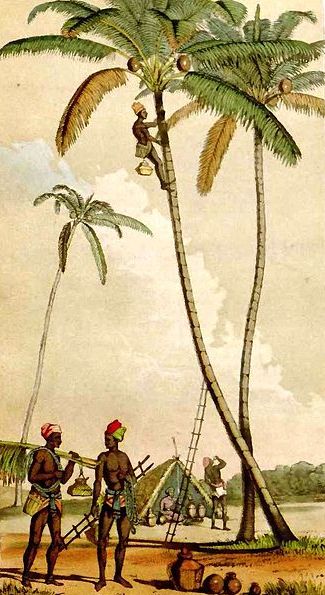Fermentation technology is as old as Vedas in Ancient India.
It has laid the foundation of alchemy and chemistry.

A sweet drink like Soma Rasa, prepared by the Vedic people is the first product of fermentation in India.
Rigveda indicates that fermentation technology took its first step in connection with the preparation of Soma juice in India.
There is also another drink, known as Sura (wine/beer), prepared by fermentation. These two fermented drinks have also been used in different medicinal preparations, surgical procedures and in many chemical and alchemical operations.
Acetic fermentation was known to India since the early vedic age.
Curd (Yogurt) is another very popular fermentation product described in the Rigveda. It still remains a popular food which is formed by fermenting milk overnight.
Technology of curdling milk is also found in Yajurveda.
In the beginning, fermentation was mainly associated with the preparation of spiritual drinks, but later on it was used for other purposes also.
The different terms associated with fermentation in various texts are as follows :
- Asuta (begetting a new form)
- Abhisuta (extraction, may indicate extraction from fermented smash)
- Parisrut (‘foaming’, ‘fermenting’, that is, the state of fermenting)
- Sandhaana (complete absorption of ferment with fermenting material)
All these terms, chiefly signifying “brewing”, were part of the process of fermentation. Except the last term, all the other terms are found in Vedic literature.
Fermentation technology is mainly based on four ingredients/processes like :
1. Base material (yoni)
2. Ferment or yeast (kinva, nagnahu), alternatively, auxiliary (sambhara), providing flavor and good taste to liquor in addition to fermenting
3. Heating or digesting
4. Fermenting vessels.
Two drinks mentioned in Vedas are are Soma and Sura.
Rigveda describes Soma as a godly concoction, while Sura is described as mainly a human drink. However, Yajurveda uplifts Sura to the status of Soma.
Fermentation mentioned in Rigveda
Soma is an invigorating plant product generally prepared by squeezing juice from plants.
Following statements give an indication of fermentation:
Admixture of a thick juice of Soma with barley powder ( RigVeda . IX. 68.4).
This statement is a clear indication of fermentation with barley.
“Fifteenth day old highly intoxicating Soma” ( RigVeda . X.27.2). In this statement fifteenth day probably refers to the broth fermented in the vat for 15 days.
“Soma being treated is red” ( RigVeda .IX.82: 1) (Soma could be similar to Red Wine in color)
All these statements give an indication of fermentation technology involved in the preparation of Soma Rasa Recipe.
Fermentation mentioned in Yajurveda
Sukla Yajurveda ( Vaj. XIX. 13-15; 82-83) describes the formation of two stimulating drinks – Sura and Parisrut.
Sura was supposed to be prepared from germinated paddy, germinated barley, and parched rice with the help of ferment. Yeast was used most often as the fermenting agent.
Katyayana Srauta sutra (XV, 9.28-30; XIX, 1-2) also gives a complete description of the preparation of Sura.
According to this method, either boiled rice or boiled barley was mixed with the ferment and also with masara and the entire mixture was kept in a jar.
This jar was then kept in a pit for three nights. Meanwhile, cow’s milk and powdered parched rice were poured in the pit.
Preparation of Vinegar (Amla) in Ancient India
According to Kautilya, there were two types of amla preparations. One method involved the use of fruit juice and phalamla , while the other was derived from molasses. Its preparation was done for a longer time so that the product became sour. Kautilya further states that these were home-made products.
Medaka (spiced rice beer), Prasanna (spiced barley or wheat beer), Asava (sugarcane beer), Arista (medical tincture), etc, were some of the most popular drinks of that period. Different varieties of fermented liquor provide us the knowledge of different fermentation processes developed during that period.
Fermentation Technology in later years
Fermentation technology advanced in the field of medical science and chemical and alchemical practices.
A large number of digesting methods now came into existence. Some of these digesting methods were:
- The fermenting vessel was deposited into the earth and sometimes the vessel was covered with horse dung.
- The fermenting vessel was placed on a heap of grains.
- The fermenting vessel was exposed to the sun.
- Fumigation of the desired substance was done in a pot.
 The alcoholic fermentation and acetous fermentation began to be used for several purposes now by changing the base material or by slightly modifying the digesting methods. Base material was known as yoni and the fermented produces were known as tri-yoni, dvi-yoni, etc.
The alcoholic fermentation and acetous fermentation began to be used for several purposes now by changing the base material or by slightly modifying the digesting methods. Base material was known as yoni and the fermented produces were known as tri-yoni, dvi-yoni, etc.
The juicy produce that was obtained from the fermented smash was known as Jata-rasa.
The liquid obtained from the boiled substance was also used for the processes of fermentation.
Ancient India has alchoholic drinks from two different species of coconut palm trees which were fermented on trees itself by exposing fruits to sunlight. One was sweeter and other was stronger.
Fermented alchoholic drink was also made from Madhuca longifolia tree, which is good for health and stamina.
Fermentation products, arista, asava and sura, were considered potent medicinal drugs. Similarly, aranala, cukra, dhanyamala, kanjika, sauviraka, sukta, tusambu, etc, were not only used for medicinal purposes but also used for washing of metals and minerals and for different mercurial operations.
Arista : Powder of certain selected drugs of desired medicinal properties as well as fermenting properties mixed with water, iron powder and treacle was used for the preparation of arista . Water taken was about half of the weight of the powder while iron powder and treacle taken were 28 ½ times the weight of water. All of these ingredients were placed in an earthen vessel. The earthen vessel was coated with a mixture of honey, butter and powdered long-pepper plant from inside. Now the sealed earthen pot was placed in a mass of barley for at least seven nights for fermentation to take place.
Asava : A mixture of either cold alkaline water or sesamum and juice of sugarcane was taken for the preparation of asava . These were taken in the ratio of 2: 3 respectively. The process of fermentation was the same as that of arista .
Sura : In the preparation of Sura a decoction of a mixture of desirable drugs was taken with the ferment. This preparation was also similar to that of arista and asava .
Not only references to these medicated liquors but a number of other fermented liquors with their respective medicinal values are found in Charaka and Susruta-Samhitas.
